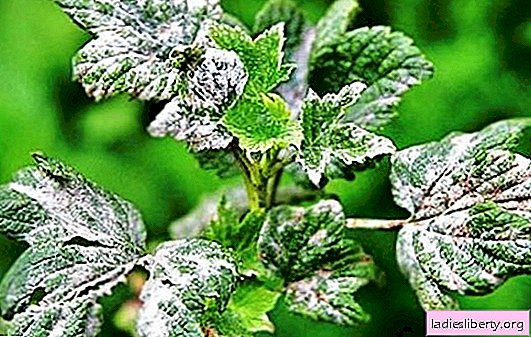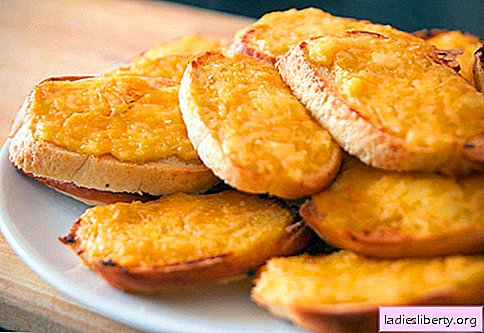
Growing currants on the site, you need to be prepared to withstand various plant diseases.
Varieties of white and red currants are more resistant to damage, but black varieties are often affected by diseases.
How to recognize and treat them?
Powdery mildew - white plaque on black currant
If currants get sick with powdery mildew - this is not a sentence. The main thing is to recognize the disease in time and start treatment.
Causative agent of the disease - a pathogenic fungus that infects seedlings, young leaves, shoots and buds, fruits. The peak of the disease occurs in July. The first signs can be found on the back of the sheet, it is covered with white coating. This is the mycelium of the fungus, which grows and affects the entire plant, while the spores themselves become dense like felt.
Launched plants stop developing, the growth point dies. The leaf cover of a diseased shrub becomes ugly: the leaves are smaller, curled, shortened. The fruits that are tied fall along with the leaves. Productivity is sharply reduced.
Sick plants are not able to survive the winter, they often die in cold weather. Even if the bush begins to grow again in spring, the wintering forms of the fungus will not allow it to fully develop. Without treatment, blackcurrant will die the same year.

The causes of white plaque on currants
In order to avoid further infection of currants with powdery mildew, it is necessary to identify the reasons why the plant is affected by the disease.
1. The cause of the defeat of currants can be warm and humid weather. It is in this climate that the fungus is most active.
2. The lack of light during cultivation can serve as an impetus for the development of the disease. Currants prefer well lit areas.
3. Thickened planting is another reason that leads to powdery mildew. Too small a distance between plants contributes to the rapid spread of the disease.
Important! The pathogenic flora is not afraid of sub-zero temperatures; it successfully winters in soil or on plant debris. With the onset of comfortable conditions, it begins to grow rapidly.
Currant leaves are covered with white coating: how and with what, to process
The fight against powdery mildew on currants comes down to treatments. Almost all old plant varieties are subject to damage. The treatment of such shrubs will not bring benefits, but rather harm. After all, large doses of chemicals are poison! It is better to get rid of old varieties, and in return plant more stable new species that are processed.
At the first sign of damage, you need to immediately treat the plant. In this case, the spray solution should fall on the entire plant, on both sides of the leaf. Processing is carried out in the evening or in cloudy weather, on hot days it is better to wait.
In order to prevent spraying, shrubs begin in early spring and are carried out in several stages.
• The first treatment is carried out immediately after a period of rest;
• The second - before budding;
• The third time spraying is done before flowering;
• The fourth time - after it;
If necessary, carry out additional processing after harvesting. The interval between them should be at least 10 days.
To treat advanced forms of the disease, chemical preparations are used that are used exactly according to the instructions, without violating the dosage. These include all copper-containing fungicides and sulfur-based preparations.
• Topaz;
• Forecast;
• Impact.
Currant Processing Tips
Experienced gardeners apply time-tested processing methods that are very helpful in controlling powdery mildew.
1. In the fall, they are treated with 3% Nitrofen solution, 1% DNOC solution, 5% copper sulfate mixture. If the treatment is carried out in the spring, then you need to do this until the plant has started to grow, that is, before the buds open. Also, for the purpose of prevention, they cultivate the soil around shrubs, destroying wintering forms of the fungus.
2. Immediately before the flowering shrubs are treated with 1% solution of colloidal sulfur. You can repeat the spraying after flowering until the fruit is formed.
Prevent Disease - Half Success
Everyone knows that prevention is the best treatment. Therefore, you need to adhere to all the rules for caring for black currant so that white plaque does not appear on its leaves.
1. To grow in the suburban area only resistant varieties of currants: Temptation, Grace, Charm and others.

2. All planting material must be disinfected. To do this, use any preparations containing copper. Before planting, the seedlings are soaked in a 1% solution.
3. Be sure to fight weeds on the site. Many pests that settle on weeds carry fungal spores. And also weaken the plant, reduce its immunity.
4. In autumn, all affected shoots need to be cut and burned. Remove all fallen leaves and fruits that are a source of infection.
5. In early spring, sanitary cleaning of plants, cultivation and digging of the soil are mandatory.
It is possible to cure currant bushes from white plaque on the leaves, only with the help of comprehensive measures and prevention. Fighting the disease on old specimens is inconclusive.
Folk ways to deal with white plaque on currant
Good results show the treatment of currants with folk remedies, which are more gentle on the plant.
• Mullein solution
To spray the currants, a mullein infusion is prepared. In a bucket of water, 1/3 of the mullein is bred and insisted in a warm place for several days. Then the finished solution is filtered and diluted with water in a ratio of 1: 3. Spraying is carried out in three stages: shortly before flowering, after it and as soon as the leaves fall.
• Ash infusion
This infusion should be used at the first signs of damage to the currant with powdery mildew. On a bucket of warm water take up to 300 grams of ash. When processing, you need to ensure that the plant is well covered with a solution. Good results are obtained by dusting shrubs with ash. Spend it after rain or spraying.
• Soda ash solution
With this mixture, it is good to process not only the leaf cover of currants, but also the soil around the shrub. For its preparation using 100 grams of soda and the same amount of laundry soap. All components are dissolved in 200 liters of water.
• Onion infusion as a preventive measure
In the spring, plantings are treated with onion infusion. To do this, prepare a strong solution of 2 kg of onion husks and 5 liters of water.
• Milk serum
Experienced gardeners use whey to treat currants. For 9 liters of water, take 1 liter of liquid. Such treatments must be carried out repeatedly, wetting the shrub well.
• Antibiotics for the treatment of currants
The treatment of plants with antibiotics gives a good effect: tetracycline, streptomycin, penicillin are diluted in water in a ratio of 1: 1: 1.
Treatment of white plaque on currants with folk remedies is based on microorganisms that are formed in decoctions and infusions in sufficient quantities to suppress fungal colonies.
Powdery mildew is a difficult disease, and a parasitic microorganism that leads to the withering of not only currants, but also most fruit crops. Fighting white plaque on currant leaves will help protect other plants in the garden.











